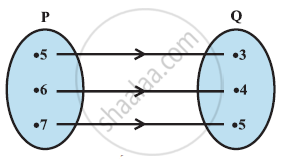Advertisements
Advertisements
Question
Is the given relation a function? Give reasons for your answer.
f = {(x, x) | x is a real number}
Solution
f = {(x, x) | x is a real number}
This means the relation f has elements which are real number.
Therefore, for every x ∈ R there will be unique image.
A relation is said to be function if every element of one set has one and only one image in other set.
Hence, f is a function.
APPEARS IN
RELATED QUESTIONS
Let A = {1, 2, 3, …, 14}. Define a relation R from A to A by R = {(x, y): 3x – y = 0, where x, y ∈ A}. Write down its domain, codomain and range.
Define a relation R on the set N of natural numbers by R = {(x, y): y = x + 5, x is a natural number less than 4; x, y ∈ N}. Depict this relationship using roster form. Write down the domain and the range.
The given figure shows a relationship between the sets P and Q. Write this relation
- in set-builder form.
- in roster form.
What is its domain and range?

Let R be the relation on Z defined by R = {(a, b): a, b ∈ Z, a – b is an integer}. Find the domain and range of R.
Find the inverse relation R−1 in each of the cases:
(iii) R is a relation from {11, 12, 13} to (8, 10, 12] defined by y = x − 3.
Let R be a relation from N to N defined by R = {(a, b) : a, b ∈ N and a = b2}. Is the statement true?
(a, b) ∈ R and (b, c) ∈ R implies (a, c) ∈ R
Justify your answer in case.
Let R be a relation on N × N defined by
(a, b) R (c, d) ⇔ a + d = b + c for all (a, b), (c, d) ∈ N × N
Show that:
(i) (a, b) R (a, b) for all (a, b) ∈ N × N
If R = {(x, y) : x, y ∈ Z, x2 + y2 ≤ 4} is a relation defined on the set Z of integers, then write domain of R.
If A = [1, 3, 5] and B = [2, 4], list of elements of R, if
R = {(x, y) : x, y ∈ A × B and x > y}
Let A = [1, 2, 3, 5], B = [4, 6, 9] and R be a relation from A to B defined by R = {(x, y) : x − yis odd}. Write R in roster form.
R is a relation from [11, 12, 13] to [8, 10, 12] defined by y = x − 3. Then, R−1 is
Let R be a relation from a set A to a set B, then
If (x − 1, y + 4) = (1, 2) find the values of x and y
Let A = {1, 2, 3, 4), B = {4, 5, 6}, C = {5, 6}. Verify, A × (B ∪ C) = (A × B) ∪ (A × C)
Select the correct answer from given alternative.
Let R be a relation on the set N be defined by {(x, y)/x, y ∈ N, 2x + y = 41} Then R is ______.
Select the correct answer from given alternative
If A = {a, b, c} The total no. of distinct relations in A × A is
Answer the following:
Show that the following is an equivalence relation
R in A is set of all books. given by R = {(x, y)/x and y have same number of pages}
A Relation R is given by the set `{(x, y)/y = x + 3, x ∈ {0, 1, 2, 3, 4, 5}}`. Determine its domain and range
Represent the given relation by
(a) an arrow diagram
(b) a graph and
(c) a set in roster form, wherever possible
{(x, y) | y = x + 3, x, y are natural numbers < 10}
A company has four categories of employees given by Assistants (A), Clerks (C), Managers (M), and an Executive Officer (E). The company provides ₹ 10,000, ₹ 25,000, ₹ 50,000, and ₹ 1,00,000 as salaries to the people who work in the categories A, C, M, and E respectively. If A1, A2, A3, A4, and A5 were Assistants; C1, C2, C3, C4 were Clerks; M1, M2, M3 were managers and E1, E2 was Executive officers and if the relation R is defined by xRy, where x is the salary given to person y, express the relation R through an ordered pair and an arrow diagram
Discuss the following relation for reflexivity, symmetricity and transitivity:
On the set of natural numbers the relation R defined by “xRy if x + 2y = 1”
On the set of natural numbers let R be the relation defined by aRb if 2a + 3b = 30. Write down the relation by listing all the pairs. Check whether it is reflexive
Choose the correct alternative:
Let f : R → R be defined by f(x) = 1 − |x|. Then the range of f is
A relation on the set A = {x : |x| < 3, x ∈ Z}, where Z is the set of integers is defined by R = {(x, y) : y = |x| ≠ –1}. Then the number of elements in the power set of R is ______.
Let N denote the set of all natural numbers. Define two binary relations on N as R1 = {(x, y) ∈ N × N : 2x + y = 10} and R2 = {(x, y) ∈ N × N : x + 2y = 10}. Then ______.
